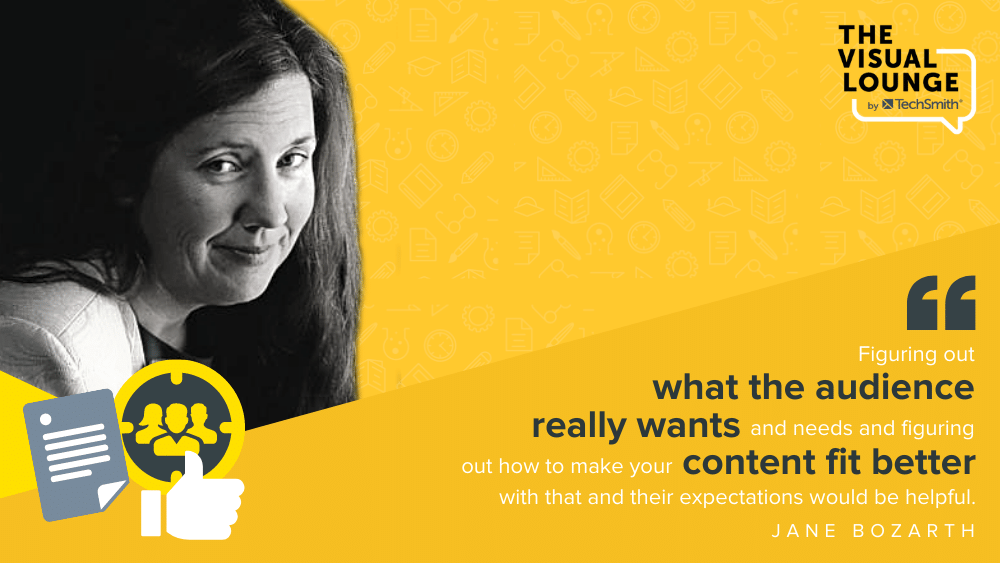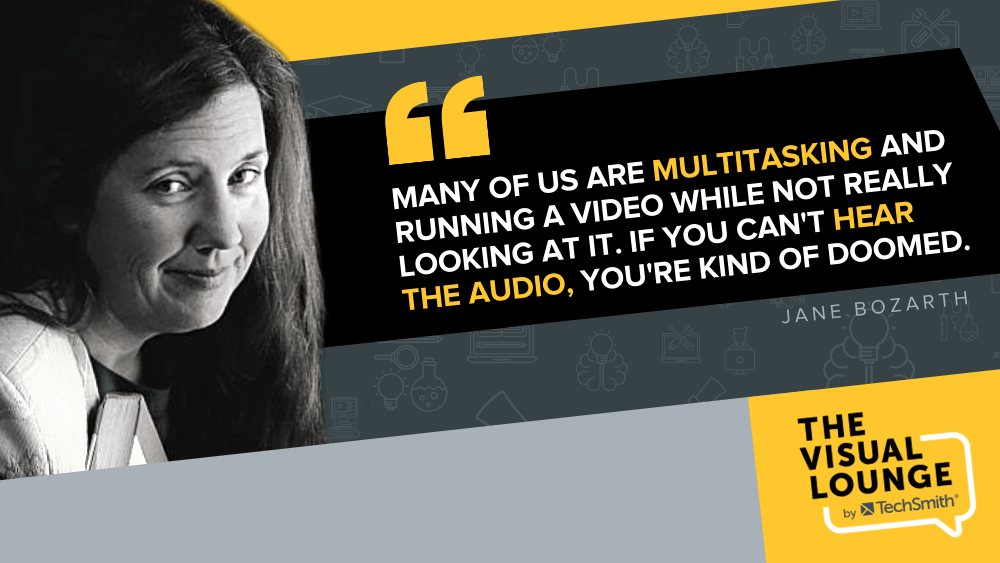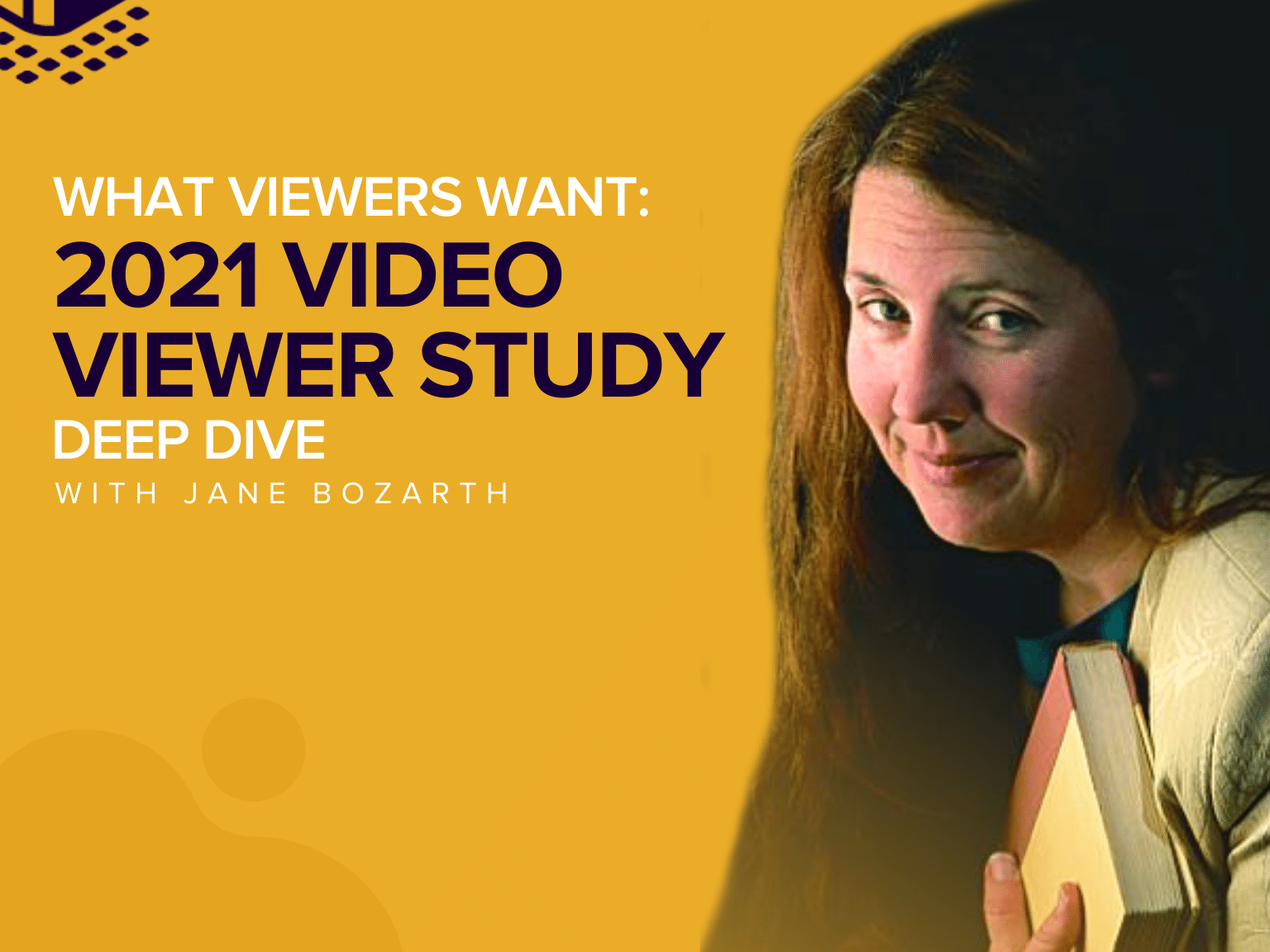What’s new in the world of instructional and informational video?
If you’re in the business of creating videos, having the latest research and stats at hand is always important.
Luckily, we’ve got you covered. We’ve just released our 2021 Video Viewer Study – a collaboration between TechSmith and Dr. Jane Bozarth, Director of Research at The Learning Guild.
We publish this study every year, but this time, we invited Jane to help us out as an unbiased third party. Jane joined this special episode of The Visual Lounge to discuss the most interesting findings and what they mean for video creators going forwards.
Take a look at our updated findings on video viewer habits and trends, or tune in to the episode below to hear more from Jane.
Jane is a veteran classroom trainer who transitioned to the world of eLearning in the late 90s and hasn’t looked back since. Jane now specializes in finding low-cost ways to provide online training solutions. She’s the author of several books, including E-Learning Solutions on a Shoestring, Social Media for Trainers, and Show Your Work: The Payoffs and How-To’s of Working Out Loud.
You can watch the video on this topic at the top of this post, to listen to the podcast episode, hit play below, or read on for more…
The methodology
Close to 1,000 people took part in this study, coming from six different markets around the world. We wanted a variety of respondents, not just TechSmith customers, to get a well-rounded picture of what video viewer habits are really like.
In terms of questions, Jane used the usual types of questions from other video viewer studies with a few tweaks.
Here are some of the key findings.
Video is still the king of content
Over the past few years, there’s been a clear shift towards video. It’s largely overtaken the written word as people’s go-to method for getting information. Our findings show that a whopping 83% of respondents prefer video to reading text or listening to audio.
But why is that?
One thing that Jane highlights is that from video, you can get the benefit of visuals and audio, so it’s the best of both worlds. Also, with the popularity of video resources like YouTube and even TikTok, video has become more accessible than ever.
“I think that we certainly see with the popularity of tools like YouTube and now TikTok, that video is so easy to create, and it’s so accessible, and is less work than reading. I think it’s just obvious people are leaning into that, increasingly, as time goes by.”
Why people watch videos
People watch videos for all sorts of reasons, but generally, people need a specific reason to watch an instructional or informational video. The research suggests that 23% of people chose to watch videos because they’re interested in learning more about a topic.
But what makes them choose a specific video? There are countless YouTube videos out there to choose from.
Our research found that the top reason was when a video description matched what a viewer wanted to learn about. Other reasons were being required to watch it by their workplace, it had an interesting title, it was a good length, and it looked entertaining.
One of the top questions Jane sees is, “how long should the video be?” But this finding suggests there are other more important factors at play. Titles and descriptions are more of a priority for viewers than the length of a video.
“When thinking about titles and descriptions, also think about keywords. What words are people searching for? Because they may be different than the words you would search for. What results do viewers want when they’re looking for videos on your topic?”
How long should a video be?
It’s one of the top questions people ask, and there’s never one single answer other than “it depends.” Our research showed a good mix of results when people were asked what video length they prefer for instructional videos.
Most respondents fell into the range between 3-19 minutes long, with a fairly equal number preferring 3-4 minutes (21%) and 10-19 minutes (22%).
Interestingly, the perceived value of a video was diminished if it was less than 2 minutes long. Those who preferred very short videos were also more likely to select ‘reading text’ as their preferred method of consuming content.
Our suggestion for best video length is that it’s as long as it needs to be to cover the subject – but as short as possible.
Another thing to consider when looking at video length is why people are watching. Someone who wants to watch a video to learn something they’re interested in will be more comfortable with longer videos. However, if you’re made to watch a video for work, you’ll understandably want it to be shorter. That’s one big reason why the findings for this question are always so varied.
What does the viewer want?
We probably didn’t need a whole study to tell you that what the viewer wants is essential for any video creator to think about.
If you want people to watch your videos and learn something, you need to address what they need and want and tailor your video to deliver that.

“I think figuring out what it is the audience really wants and needs and figuring out how to make your content fit better with that, and their expectations would be helpful.”
Jane had some interesting food for thought on this. Sometimes video creators and marketers can go overboard on this idea. They start trying to over-promise with their video titles to get people to click on them.
“I think sometimes the attractive title may over-promise, and then you get two minutes in, and this isn’t at all what they said was going to be covered. I think we need to strike a balance between a descriptive, entertaining, engaging, interesting, attractive title and just telling the truth.”
Keeping people watching
It’s one thing to get someone to click on your video. It’s another job to get them to stick around.
Firstly, it’s important to note that not everyone who decides not to finish a video doesn’t like it. Sometimes they get the answer they’re looking for and move on quickly. Other times, the viewer didn’t get what they needed and moved on to another video.
In our research, the top thing that kept viewers watching was ‘it was easy to follow along,’ followed by the content being relatable and current and the speaker being engaging and knowledgeable.
But what makes people close a video? Jane highlighted one common issue she sees a lot in homemade instructional videos. The type of videos that are unrehearsed and disorganized can be very difficult to follow. And viewers aren’t going to stick around for that.
“Watching somebody who has not set something up in a logical way to follow is like watching somebody who’s not good at telling a joke.”
The good thing is that this is a pretty easy fix and requires some planning before you hit record. That way, you can cover everything you want in an order that makes sense, which keeps your viewers watching.
The most important thing about video
Let’s say you can only focus on one thing in your video. What would it be? Many video creators would say that video quality is key, but the stats say something different.
Yes, video quality is important, but good audio is essential. It’s something we’ve talked about a lot on The Visual Lounge – bad audio can ruin an otherwise great video.
Jane gave a great reason for this:

“Many of us are multitasking. And maybe we’re running a video and not really looking at it. If you can’t hear the audio, you’re kind of doomed.”
For those just listening to the video, bad audio can totally distract from the meaning and is enough for a viewer to close your video and move on to another. So, if you have to focus on one thing, make it the audio first.
There are plenty more insights from Jane and the study in the full episode of The Visual Lounge. We’d highly recommend scrolling to the top and watching/listening to it, and also checking out the full Video Viewer Study report.
For more video tips and handy resources on creating videos people love to watch, head over to the TechSmith Academy.





